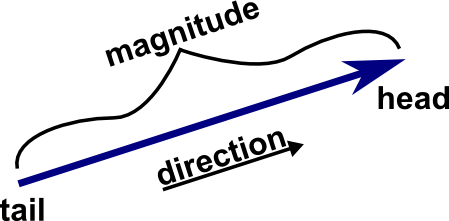Vector
A vector is a line that has both magnitude and direction
- therefore it can represent:
- the force of gravity on an object
- the strength and direction of the Earth's magnetic field
- velocity of a particle in a flowing fluid
- an area (here, all we have to do is make the vector the same length as the 2D surface, and make its direction perpendicular to that surface)

Basis Vectors
Basis vectors have a length of 1 unit, and have a direction that is equal to one of the coordinate axes.
-
in a 3D cartesian coordinate system, we have 3 coordinate axes (, , ). The basis vectors must be alone one of these lines.
-
(sometimes ) - represents a basis vector along the axis
-
(sometimes ) - represents a basis vector along the axis
-
(sometimes ) - represents a basis vector along the axis
Vector Components
The components of a vector tell us how much of each coordinate (e.g , , ) we need to get to the tip of our line (remember, the vector starts at , so by getting the coordinate we also know exactly how long the line is)
-
ex. with coordinates , the component of our line is , and the components is
-
- represents the vector component of Vector
In order to find the components of the vector, we must first have in place the coordinate system and the basis vectors
Backlinks